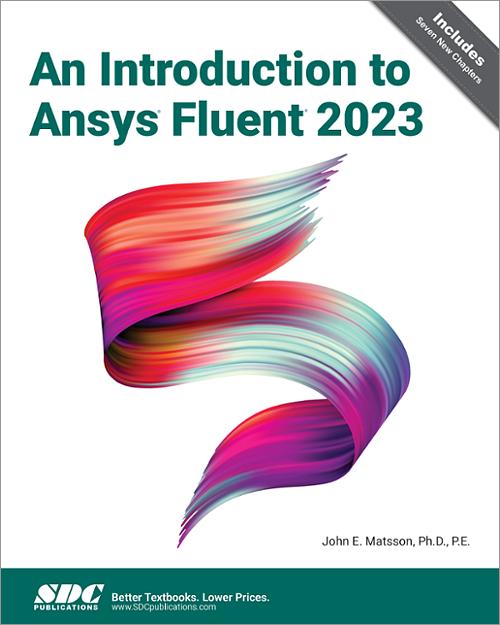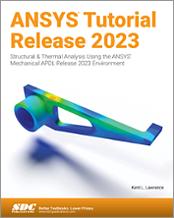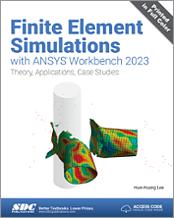An Introduction to Ansys Fluent 2023
- Description
- Contents
- Downloads
- Instructor Resources
- Details
Description
Key Features
- Teaches new users how to run Computational Fluid Dynamics simulations using Ansys Fluent
- Uses applied problems, with detailed step-by-step instructions
- Designed to supplement undergraduate and graduate courses
- Covers the use of Ansys Workbench, Ansys DesignModeler, Ansys Meshing, Ansys Fluent and Ansys Polyflow
- Compares results from Ansys Fluent with numerical solutions using Mathematica
- This edition features seven new chapters analyzing deposition flow, drop impact, supersonic flow over cone and through a nozzle, and draping, free forming and blow molding of plastics
In Detail
As an engineer, you may need to test how a design interacts with fluids. For example, you may need to simulate how air flows over an aircraft wing, how water flows through a filter, or how water seeps under a dam. Carrying out simulations is often a critical step in verifying that a design will be successful. In this hands-on book, you’ll learn in detail how to run Computational Fluid Dynamics (CFD) simulations using Ansys Fluent. Ansys Fluent is known for its power, simplicity and speed, which has helped make it a world leader in CFD software, both in academia and industry.
Unlike any other Ansys Fluent textbook currently on the market, this book uses applied problems to walk you step-by-step through completing CFD simulations for many common flow cases, including internal and external flows, laminar and turbulent flows, steady and unsteady flows, and single-phase and multiphase flows. You will also learn how to visualize the computed flows in the post-processing phase using different types of plots. To better understand the mathematical models being applied, we’ll validate the results from Ansys Fluent with numerical solutions calculated using Mathematica.
Throughout this book we’ll learn how to create geometry using Ansys Workbench and Ansys DesignModeler, how to create mesh using Ansys Meshing, how to use physical models and how to perform calculations using Ansys Fluent. The chapters in this book can be used in any order and are suitable for beginners with little or no previous experience using Ansys. Intermediate users, already familiar with the basics of Ansys Fluent, will still find new areas to explore and learn. An Introduction to Ansys Fluent 2023 is designed to be used as a supplement to undergraduate courses in Aerodynamics, Finite Element Methods and Fluid Mechanics and is suitable for graduate level courses such as Viscous Fluid Flows and Hydrodynamic Stability.
The use of CFD simulation software is rapidly growing in all industries. Companies are now expecting graduating engineers to have knowledge of how to perform simulations. Even if you don’t eventually complete simulations yourself, understanding the process used to complete these simulations is necessary to be an effective team member. People with experience using Ansys Fluent are highly sought after in the industry, so learning this software will not only give you an advantage in your classes, but also when applying for jobs and in the workplace. This book is a valuable tool that will help you master Ansys Fluent and better understand the underlying theory.
Topics Covered
- 2D Axisymmetric Flow
- 2D Axisymmetric Swirl
- 3D Flow
- Animation
- Batch Job
- Boundary Conditions
- Cell Zone Conditions
- CFD-Post
- Compressible Flow
- Contours
- Drag and Lift
- Dynamic Mesh Zones
- Fault-tolerant Meshing
- Fluent Launcher
- Force-Report
- Initialization
- Iterations
- Laminar and Turbulent Flows
- Macroscopic Particle Model
- Materials
- Meshing
- Multiphase Flows
- Nodes and Elements
- Pathlines
- Polyflow
- Post-Processing
- Pressure
- Project Schematic
- Reference Values
- Reports
- Residuals
- Results
- Sketch
- Solution
- Solver
- Streamlines
- Supersonic Flow
- Transient
- User Defined Functions
- Viscous Model
- Visualizations
- XY Plot
- Watertight-Geometry
Table of Contents
- Introduction
- Flat Plate Boundary Layer
- Flow Past a Cylinder
- Flow Past an Airfoil
- Rayleigh-Benard Convection
- Channel Flow
- Rotating Flow in a Cavity
- Spinning Cylinder
- Kelvin-Helmholtz Instability
- Rayleigh-Taylor Instability
- Flow Under a Dam
- Water Filter Flow
- Model Rocket Flow
- Ahmed Body
- Hourglass
- Bouncing Spheres
- Falling Sphere
- Flow Past a Sphere
- Taylor-Couette Flow
- Dean Flow in a Curved Channel
- Rotating Channel Flow
- Compressible Flow Past a Bullet
- Vertical Axis Wind Turbine Flow
- Circular Hydraulic Jump
- Optimized Elbow
- Golf Ball
- Model Car: Audi R8
- Drop Impact on Fluid Layer
- Deposition Flow in Additive Manufacturing
- Draping of Plastic Sheet
- Free Forming of Plastic Sheet
- Blow Molding of Plastic Bottle
- Supersonic Flow Past a Cone
- Shock Diamonds
Index
Downloads
For additional information on downloading, unzipping, and using these files visit the downloads section on our FAQ page.
Instructor Resources
The following downloadable resources require that you are registered, logged in and have been authenticated as an instructor.
Product Details
| Publisher | SDC Publications |
| Authors | John E. Matsson Ph.D., P.E. |
| Published | June 26, 2023 |
| User Level | Beginner - Intermediate |
| Pages | 932 |
| Binding | Paperback |
| Printing | Black and White |
| Print ISBN | 978-1-63057-648-6 |
| Print ISBN 10 | 1630576484 |
| eBook ISBN | 978-1-63056-868-9 |


